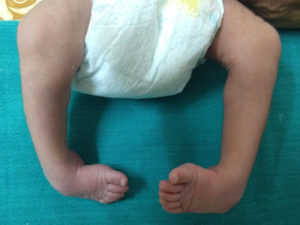Club foot
Clubfoot (also called Congenital Talipes Equino Varus- CTEV) is a birth defect that can affect one or both feet. Early treatment usually helps to correct it. If your baby has clubfoot, one or both feet points down and inwards with the sole of the foot facing backwards.
Clubfoot is not painful for babies, but if it isn’t treated, the deformity persists or worsens and it can become painful and make it difficult to walk as they get older. Clubfoot is quite common in India, affecting about 2-3 babies in every 1,000 live births. Both feet are affected in about half of these babies. It is more common in boys than girls.
Diagnosing club foot
- Clubfoot is usually diagnosed after a baby is born- parents make out the misshapen foot easily- the doctor will be able to differentiate it from other similar foot problems.
- Doctors also examine the baby to make sure that he does not have any other diseases which are sometimes seen along with clubfoot (Eg. Meningomyelocele, arthrogryposis, some syndromes-complex diseases affecting multiple organs
- Clubfoot may be spotted in pregnancy during the routine ultrasound scan carried out after 18 and 21 weeks. Though it can’t be treated before birth, but picking up the problem during pregnancy means you can talk to doctors and find out what to expect after your baby is born.

Treating club foot
Plaster treatment:
Treatment for clubfoot usually starts within a week or two of your baby being born. A technique known as the Ponseti method is the main treatment for club foot nowadays. This involves gently manipulating your baby’s foot into a better position, then putting it into a plaster cast. This is repeated every week for about 5-6 weeks.

At our centre we follow an accelerated Ponseti method in which plaster casts are applied twice a week. This also requires 5-6 plasters to correct the misshapen foot. Just before the last cast, most babies need a minor operation to loosen the tendon at the back of their ankle (Achilles tendon). This is done using a local anaesthetic. It helps to release their foot into a more natural position.Your baby will need to wear special boots attached to each other with a bar (clubfoot brace) to prevent the clubfoot returning. They’ll need to wear these boots 23 hours a day for the first 3 months, then the duration is gradually reduced so that once the child starts walking he/she has to wear the brace only during night and day time naps. This is continued till an age of 4-5 years.

Most parents think that once the foot has regained its normal shape then it needs no attention. This is a wrong concept which can lead to poor results. Once the last plaster comes off, it just finishes only half of the treatment for clubfoot. The remaining treatment strict adherence to the brace wear timings and instructions from the doctor is crucial for the success of the treatment. The most important reason for return of the disease once it has been completely corrected is failure to put on the brace for adequate time. If this unfortunate thing happens, then the doctor may decide to put a few plaster casts again or (if the foot shape has become too bad) do corrective surgery.
Surgeries:
Posteromedial soft tissue release:
In this surgery, all the tight tissues on the inner aspect and back of the foot are divided or lengthened and the foot is put on a plaster cast. This is usually done for children:
1. who present first time after walking age
2. who had incomplete treatment
3. for whom the foot has gone back to bad form due to inadequate use of brace
Many children who come under (1), (2) or (3) may be treated fully with plaster casts alone, without surgery. This decision depends on your doctor’s skill and the severity of clubfoot of your child.
Osteotomy:
This means cutting bones and correcting the deformed foot to near normal shape. It may be needed once the child’s foot has become quite stiff and does not correct only with posteromedial soft tissue release.
Ilizarov ring fixator:
This involves fixing a frame made of metallic rings outside and around the foot and leg in the operation theatre. Starting from a few days after the surgery, gradual correction of shape of the foot is done by turning nuts within the frame. The foot is slowly brought back to near normal shape taking a few weeks.This treatment is done for children >6 years of age whose feet are in quite bad shape and very stiff- because
(1) they received no treatment or incomplete/improper treatment before
(2) the clubfoot returned after plaster treatment or surgery due to not using brace as advised by doctor.

Arthrodesis:
The procedures mentioned above can be done only if the child is young. If the child is older than 12-14 years then the misshapen foot can be corrected only with procedure which fuses joints between bones in the foot- called arthodesis. This surgery is reserved for very deformed clubfeet in older children because even though it corrects the shape, it decreases the movement of foot and makes it stiff.
Outcomes
Arthrodesis:
Clubfoot does not resolve on its own. With treatment, most clubfeet are correctable and have good function. The affected foot may always be smaller than the other foot, and the calf on the affected side may also always be smaller.

